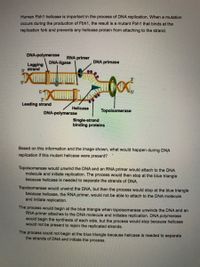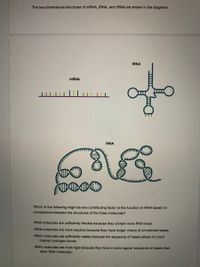
Human Anatomy & Physiology (11th Edition)
11th Edition
ISBN: 9780134580999
Author: Elaine N. Marieb, Katja N. Hoehn
Publisher: PEARSON
expand_more
expand_more
format_list_bulleted
Concept explainers
Topic Video
Question

Transcribed Image Text:Human Fbh1 helicase is important in the process of DNA replication. When a mutation
occurs during the production of Fbh1, the result is a mutant Fbh1 that binds at the
replication fork and prevents any helicase protein from attaching to the strand.
DNA-polymerase
RNA primer
DNA-ligase
DNA primase
Lagging
3' strand
3'
5
5'
5'
3'
Leading strand
Helicase
DNA-polymerase
Topoisomerase
Single-strand
binding proteins
Based on this information and the image shown, what would happen during DNA
replication if this mutant helicase were present?
Topoisomerase would unwind the DNA and an RNA primer would attach to the DNA
molecule and initiate replication. The process would then stop at the blue triangle
because helicase is needed to separate the strands of DNA.
Topoisomerase would unwind the DNA, but then the process would stop at the blue triangle
because helicase, the RNA primer, would not be able to attach to the DNA molecule
and initiate replication.
The process would begin at the blue triangle when topoisomerase unwinds the DNA and an
RNA primer attaches to the DNA molecule and initiates replication. DNA polymerase
would begin the synthesis of each side, but the process would stop because helicase
would not be present to rejoin the replicated strands.
The process could not begin at the blue triangle because helicase is needed to separate
the strands of DNA and initiate the process.

Transcribed Image Text:The two-dimensional structures of mRNA, tRNA, and rRNA are shown in the diagrams.
TRNA
MRNA
FRNA
Which of the following might be one contributing factor to the function of rRNA based on
comparisons between the structures of the three molecules?
rRNA molecules are sufficiently flexible because they contain more RNA loops.
rRNA molecules are more reactive because they have longer chains of unmatched bases.
rRNA molecules are sufficiently stable because the sequence of bases allows for more
internal hydrogen bonds.
FRNA molecules are more rigid because they have a more regular sequence of bases than
other RNA molecules.
Expert Solution
This question has been solved!
Explore an expertly crafted, step-by-step solution for a thorough understanding of key concepts.
This is a popular solution
Trending nowThis is a popular solution!
Step by stepSolved in 3 steps

Knowledge Booster
Learn more about
Need a deep-dive on the concept behind this application? Look no further. Learn more about this topic, biology and related others by exploring similar questions and additional content below.Similar questions
- Which of the following enzymes ensures that the correct base of a deoxynucleotide for growing the chain is aligned with template chain? DNA gyrases DNA ligases DNA polymerases primasesarrow_forwardWhich of the following would be involved in the excision repair of a thymine dimer? O DNA polymerase I Nuclease Topoisomerase Primasearrow_forwardAn Investigator obtains a bacterial temperature-sensitive mutation that affects a step in the process of DNA replication at 42°C but not at 30°C. She grows the cells at 30°C and, upon shifting the temperature to 42°C, she discovers that the DNA remains double- stranded at the replication forks. What is the likely target affected by the temperature-sensitive mutation? DNA Ligase DNA polymerase lII primase DNA gyrase Single-stranded DNA-binding protein (SSB)arrow_forward
- How is DNA copied with leading and lagging strands? Please use these terms in a summary: Helicase Decide on the leading vs lagging strand locations Primase on leading strand DNA polymerase Primase on lagging strand Ligase Nucleasearrow_forwardDoes E. coli chromosomal replication always start at one particular site? What is called? If you were given the DNA sequence of E. coli chromosome, would you be able to identify where E. coli chromosomal replication starts? What is the end of E. coli chromosome replication?arrow_forwardIf a mutation occurred that prevented single stranded binding proteins from binding, the result would be: O Replication would not be initiated O DNA would be synthesized on the leading strand, but not the lagging strand Replicating would be initiated, DNA would unwind, RNA primers would be laid down, but DNA polymerase would not bind O The newly synthesized RNA would not be able to leave the DNA template Replication would be initiated, but RNA primers would not anneal to the DNAarrow_forward
- DNA polymerase 1 has 5' - 3' polymerase activity. 5'-3' exonuclease activity and 3'-5' exonuclease activity necessary for DNA replication. Mutations in the gene that encodes DNA polymerase 1 may cause the enzyme to lose its function. Match the consequence of the lost function mutation to the corresponding lost activity.arrow_forwardThe umami or savory taste is usually associated with which nutrient? Question 26 options: fats amino acids carbohydrates vitamins Natural gas is treated with a substance that gives it a smell in order to ______. Question 1 options: easily detect leaks prolong its shelf-life make it less flammable reduce production costsarrow_forwardWhich of the following is not necessary for replication to proceed? O MRNA O RNA primer O DNA polymerase O primase O DNA ligasearrow_forward
- As the strands are synthesized in replication, which of the following is true? the leading strand is synthesized continuously from the 5' to 3' direction while the other strand is synthesized discontinuously in the 3' to 5' direction both strands are synthesized in the 5' to 3' direction the strand that shows the Okazaki fragments is synthesized in the 3'-5' direction. both strands are synthesized continuouslyarrow_forwardWhich of the following plays a role in repairing thymine dimers by reversing the damage caused by UV light exposure in bacteria? base excision repair photoreactivation enzyme postreplication repair non-homologous end-joining repair DNA polymerase proofreadingarrow_forwardSemi-discontinuous replication means that: DNA synthesis only occurs in the same direction as the replication fork. the double helix unwinds and each strand serves as a template for a new DNA molecule. there are Okazaki fragments associated with the leading strand. DNA synthesis occurs in both a 5’ to 3’ and a 3’ to 5’ direction. there is both a leading and a lagging strand associated with each replication fork.arrow_forward
arrow_back_ios
SEE MORE QUESTIONS
arrow_forward_ios
Recommended textbooks for you
 Human Anatomy & Physiology (11th Edition)BiologyISBN:9780134580999Author:Elaine N. Marieb, Katja N. HoehnPublisher:PEARSON
Human Anatomy & Physiology (11th Edition)BiologyISBN:9780134580999Author:Elaine N. Marieb, Katja N. HoehnPublisher:PEARSON Biology 2eBiologyISBN:9781947172517Author:Matthew Douglas, Jung Choi, Mary Ann ClarkPublisher:OpenStax
Biology 2eBiologyISBN:9781947172517Author:Matthew Douglas, Jung Choi, Mary Ann ClarkPublisher:OpenStax Anatomy & PhysiologyBiologyISBN:9781259398629Author:McKinley, Michael P., O'loughlin, Valerie Dean, Bidle, Theresa StouterPublisher:Mcgraw Hill Education,
Anatomy & PhysiologyBiologyISBN:9781259398629Author:McKinley, Michael P., O'loughlin, Valerie Dean, Bidle, Theresa StouterPublisher:Mcgraw Hill Education, Molecular Biology of the Cell (Sixth Edition)BiologyISBN:9780815344322Author:Bruce Alberts, Alexander D. Johnson, Julian Lewis, David Morgan, Martin Raff, Keith Roberts, Peter WalterPublisher:W. W. Norton & Company
Molecular Biology of the Cell (Sixth Edition)BiologyISBN:9780815344322Author:Bruce Alberts, Alexander D. Johnson, Julian Lewis, David Morgan, Martin Raff, Keith Roberts, Peter WalterPublisher:W. W. Norton & Company Laboratory Manual For Human Anatomy & PhysiologyBiologyISBN:9781260159363Author:Martin, Terry R., Prentice-craver, CynthiaPublisher:McGraw-Hill Publishing Co.
Laboratory Manual For Human Anatomy & PhysiologyBiologyISBN:9781260159363Author:Martin, Terry R., Prentice-craver, CynthiaPublisher:McGraw-Hill Publishing Co. Inquiry Into Life (16th Edition)BiologyISBN:9781260231700Author:Sylvia S. Mader, Michael WindelspechtPublisher:McGraw Hill Education
Inquiry Into Life (16th Edition)BiologyISBN:9781260231700Author:Sylvia S. Mader, Michael WindelspechtPublisher:McGraw Hill Education

Human Anatomy & Physiology (11th Edition)
Biology
ISBN:9780134580999
Author:Elaine N. Marieb, Katja N. Hoehn
Publisher:PEARSON

Biology 2e
Biology
ISBN:9781947172517
Author:Matthew Douglas, Jung Choi, Mary Ann Clark
Publisher:OpenStax

Anatomy & Physiology
Biology
ISBN:9781259398629
Author:McKinley, Michael P., O'loughlin, Valerie Dean, Bidle, Theresa Stouter
Publisher:Mcgraw Hill Education,

Molecular Biology of the Cell (Sixth Edition)
Biology
ISBN:9780815344322
Author:Bruce Alberts, Alexander D. Johnson, Julian Lewis, David Morgan, Martin Raff, Keith Roberts, Peter Walter
Publisher:W. W. Norton & Company

Laboratory Manual For Human Anatomy & Physiology
Biology
ISBN:9781260159363
Author:Martin, Terry R., Prentice-craver, Cynthia
Publisher:McGraw-Hill Publishing Co.

Inquiry Into Life (16th Edition)
Biology
ISBN:9781260231700
Author:Sylvia S. Mader, Michael Windelspecht
Publisher:McGraw Hill Education